Dodge Challenger
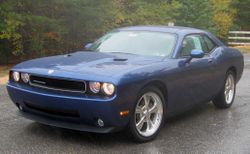 |
|
| Manufacturer | Chrysler Corporation (1970–1974) Mitsubishi Motors (1978–1983) Chrysler Group LLC (2008–present) |
|---|---|
| Production | 1970–1974 1978–1983 2008–present |
| Successor | Dodge Conquest (for 1984) Dodge Daytona (for 1984) |
| Class | Pony car (1970–1974) Subcompact car (1978–1983) Pony car (2008–present) |
| Layout | FR layout |
The Dodge Challenger is the name of three different automobile models marketed by the Dodge division of Chrysler.
The first generation was a pony car built from 1970 to 1974, using the Chrysler E platform and sharing major components with the Plymouth Barracuda. The second generation, from 1978 to 1983, was badge engineered Mitsubishi Galant Lambda. The third, and current generation, was introduced in 2008 as a rival to the evolved fifth generation Ford Mustang and the revived fifth generation Chevrolet Camaro.
Contents |
First generation (1970–1974)
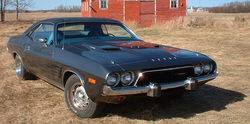 |
|
| Production | 1970–1974 |
|---|---|
| Assembly | Hamtramck, Michigan, United States Los Angeles, California, United States |
| Body style(s) | 2-door convertible 2-door hardtop |
| Platform | E-body |
| Engine(s) | 198 cu in (3.2 L) Slant 6 I6 225 cu in (3.7 L) Slant 6 I6 318 cu in (5.2 L) LA V8 340 cu in (5.6 L) LA V8 360 cu in (5.9 L) LA V8 383 cu in (6.3 L) B V8 426 cu in (7 L) Hemi V8 440 cu in (7.2 L) RB V8 |
| Transmission(s) | 3-speed manual 4-speed manual 3-speed TorqueFlite automatic |
| Wheelbase | 110.0 in (2794 mm) |
| Length | 191.3 in (4859 mm) |
| Width | 76.1 in (1933 mm) |
| Height | 50.9 in (1293 mm) |
| Related | Plymouth Barracuda |
| Designer | Carl Cameron |
The Challenger is described in a book about 1960s American cars as Dodge’s "answer to the Mustang and Camaro. "[1] It was one of two Chrysler E-body cars, the other being the slightly smaller Plymouth Barracuda. "Both the Challenger and Barracuda were available in a staggering number of trim and option levels" and were intended "to compete against cars like the Chevrolet Camaro and Ford Mustang, and to do it while offering virtually every engine in Chrysler's inventory. "[2] However they were "a rather late response to the ponycar wave the Ford Mustang had started. "[3] In his book Hemi Muscle Cars[4], Robert Genat says that the Challenger was conceived in the late 1960s as Dodge’s equivalent of the Plymouth Barracuda, and that the Barracuda was designed to compete against the Mustang and Camaro. He adds that Chrysler intended the new Dodge as "the most potent ponycar ever, " and positioned it "to compete against the Mercury Cougar and Pontiac Firebird. " Genat also notes that "the Barracuda was intended to compete in the marketplace with the Mustang and Camaro/Firebird, while the Dodge was to be positioned against the Cougar" and other more luxury-type musclecars.[5]
The Challenger's longer wheelbase, larger dimensions and more luxurious interior were prompted by the launch of the 1967 Mercury Cougar, likewise a bigger, more luxurious and more expensive pony car aimed at affluent young American buyers.[6] The wheelbase, at 110 inches (2,794 mm), was two inches longer than the Barracuda, and the Dodge differed substantially from the Plymouth in its outer sheetmetal, much as the Cougar differed from the shorter-wheelbase Ford Mustang.
Exterior design was done by Carl Cameron, who also did the exterior for the 1966 Dodge Charger. Cameron based the 1970 Challenger grille off an older sketch of his 1966 Charger prototype that was to have a turbine engine. The Charger never got the turbine, but the Challenger got that car's grille. Although the Challenger was well-received by the public (with 76,935 produced for the 1970 model year), it was criticized by the press, and the pony car segment was already declining by the time the Challenger arrived. Sales fell dramatically after 1970, and Challenger production ceased midway through the 1974 model year. About 165,500 Challengers were sold over this model's lifespan.
Models
Four hardtop models were offered: Challenger Six, Challenger V8, T/A Challenger (1970 only), and Challenger R/T with a convertible version available only in 1970 and 1971 , although there were no factory-built R/T Challenger convertibles for 1971 ; the R/T continued as a model on the hardtop body style however. The standard engine on the base model was the 225 cu in (3.7 L) six-cylinder. Standard engine on the V8 was the 230 bhp (171.5 kW)318 cu in (5.2 L) V8 with a 2-barrel carburetor. Optional engines were the 340 cu in (5.6 L) and 383 cu in (6.3 L) V8s, all with a standard 3-speed manual transmission, except for the 290 bhp (216.3 kW) 383 CID engine, which was available only with the TorqueFlite automatic transmission. A 4-speed manual was optional on all engines except the 225 CID I6 and the 2-barrel 383 CID V8.
The performance model was the R/T (Road/Track), with a 383 CID Magnum V8, rated at 335 bhp (249.8 kW); 300 bhp (223.7 kW) for 1971, due to a drop in compression. Standard transmission was a 3-speed manual. Optional R/T engines were the 375 bhp (279.6 kW) 440 cu in (7.2 L) Magnum, the 390 bhp (290.8 kW) 440 CID Six-Pack and the 425 bhp (316.9 kW) 426 cu in (7.0 L) Hemi. The R/T was available in either the hardtop or convertible. Base hardtop models and R/T hardtops could be ordered with the more luxurious SE specification, which included leather seats, a vinyl roof, a smaller 'formal' rear window, and an overhead interior console that contained three warning lights (door ajar, low fuel, and seatbelts). The Challenger R/T came with a Rallye instrument cluster that included a 150 mph (240 km/h) speedometer, an 8,000 rpm tachometer, 1972-1974 tachometer went to 7,000 rpm and an oil pressure gauge. In 1973, the R/T badging was dropped and these models were called "Rallye", although they were never badged as such. The shaker hood scoop was not available after 1971.
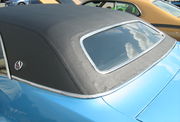
A 1970-only model was the Dodge Challenger T/A (Trans Am) racing homologation car. In order to race in the Sports Car Club of America's Trans American Sedan Championship Trans Am, it built a street version of its race car (just like Plymouth with its Plymouth 'Cuda AAR) which it called the Dodge Challenger T/A (Trans Am). Although the race cars ran a destroked version of the 340, street versions took the 340 and added a trio of two-barrel carburetors atop an Edelbrock aluminum intake manifold, creating the 340 Six Pack. Dodge rated the 340 Six Pack at 290 bhp (216.3 kW), only 15 bhp (11 kW) more than the original 340 engine (and mysteriously the same rating as the Camaro Z/28 and Ford Boss 302 Mustang), it actually made about 320 bhp (238.6 kW). It breathed air through a suitcase sized air scoop molded into the pinned down, hinged matte-black fiberglass hood. Low-restriction dual exhausts ran to the stock muffler location, then reversed direction to exit in chrome tipped "megaphone" outlets in front of the rear wheels. Options included a TorqueFlite automatic or pistol-grip Hurst-shifted four-speed transmission, 3.55:1 or 3.90:1 gears, as well as manual or power steering. Front disc brakes were standard. The special Rallye suspension used heavy duty parts and increased the rate of the rear springs. The T/A was the first US muscle car to fit different size tires front and rear to give a racing stance: E60x15 fronts, and G60x15 in back. The modified camber elevated the tail enough to clear the rear rubber and its side exhaust outlets. Thick dual side stripes, bold ID graphics, a fiberglass ducktail rear spoiler, and a fiberglass front spoiler added to the racing image. The interior was strictly stock Challenger.
Dodge contracted Ray Caldwell's Autodynamics firm in Marblehead, Mass. to run the factory Trans-Am team. Sam Posey drove the "sub-lime" painted car #77 that Caldwell's team built from a car taken off a local dealer's showroom floor! When #76 was completed mid-season from a chassis provided by Dan Gurney's All American Racers, Posey alternated between the two. Both cars ran the final two races, with Posey in #77; Ronnie Bucknum drove #76 at Seattle, and Tony Adamowicz at Riverside, CA.
The Challenger T/A's scored a few top three finishes, but lack of a development budget and the short-lived Keith Black 303 c. i. engines led to Dodge leaving the series at season's end. As of 2009, both race cars have been restored By Ed Skanes, Bryan Skanes, Dave McGaughey & Chris Brown from Lexington KY,and appear at concours and vintage races. #77 is in California and the #76 still resides in Kentucky and belongs to the restorers.
The street version suffered from severe understeer in fast corners, largely due to the smaller front tires. It could turn mid 14s in the quarter mile, which would do any small block muscle car proud. Only 2,399 T/As were made. A 1971 model using the 340 engine with a 4-barrel carburetor was planned and appeared in period advertising, but was not produced since Dodge had left the race series.
The "Western Special" was a version available only to west coast dealers. It came with a rear-exit exhaust system and Western Special identification on the rear decklid. Some examples came with a vacuum-operated trunk release. Another late production version was the low-priced "Deputy", stripped of some of the base car's trim and with fixed rear side glass.
By 1972, the convertible version and all the big-block engine options were gone. Maximum power was also downgraded to 240 horsepower (180 kW) to reflect the more accurate Society of Automotive Engineers (SAE) net hp calculations. The 1972 models also received a new grille that extended beneath the front bumper. The only 1972 convertibles which exist are actually 1971 models with the 1972 front end (grille, lights, etc.) and rear end (tail lights and their panel). These were specially built for TV programs such as "Mod Squad". The only way to ascertain a 'real' 1972 Challenger convertible is to look at its fender tag. On the code line which gives the dealer order number, that number will start with an "R", which designates "Special Meaning" (in this case, a TV 'special promotions' car).
The 1973 models were no longer available with a six-cylinder engine. For 1974, the 340 cu in (5.6 L) engine was replaced by a 360 cu in (5.9 L) version, but the pony car market had deteriorated and production of Challengers ceased in mid-1974.
Cosmetic variations
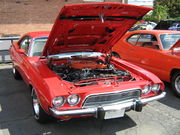
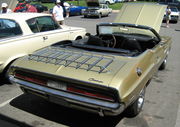
Although the body style remained the same throughout the Challenger's five year run, there were two notable changes to the front grille. The 1971 models had a "split" grille, while 1972 introduced a design that extended the grille (nick-named the "sad-mouth") beneath the front bumper. With this change to the front end, 1972 through 1974 models had little to no variation. The only way to properly distinguish them is that the 1972s had flush mounted bumpers with no bumper guards, (small bumper guards were optional), while both the 1973 and 1974 models had the protruding "5 mph (8.0 km/h)" bumpers (with a rubber type filler behind them) in conjunction with large bumper guards. The 1974 cars had larger rear bumper guards to meet the (new for 1974 and on) rear 5 mph rear impact law. These changes were made to meet U.S. regulations regarding crash test safety.
The 1970 taillights went all the way across the back of the car, with the backup light in the middle of the rear. In 1971, the backup lights were on the left and right instead of the middle. The taillight array also changed for 1972 onwards, with the Challenger now having four individual rectangular lamps.
Collectibility
Although few mourned the end of the E-body models, the passage of time has created legends and highlighted the unique personalities of both the Challenger and the Barracuda.[2] In a historic review, the editors of Edmunds Inside Line ranked these models as: 1970 was a "great" year, 1971 was "good" one, and then "three progressively lousier ones" (1972–1974).[2] With total sales/production off by 2/3rds from 1970, the performance engine 1971 Challengers are the most rare. Sales/production of the 1973 cars (with only two V8s available) actually exceeded 1971 by approximately 1,000 cars. This may be explained by 1973 being a very good year for the US auto industry in general and an increased interest in Mopar (the Plymouth Barracuda and Plymouth Road Runner also saw sales increases) performance cars.
Original "numbers matching" high-performance 1970-71 Challengers are now among the most sought-after collector cars. The rarity of specific models with big engines is the result of low buyer interest and sales with the correspondingly low production when new. The 440 and the 426 Hemi engines nowadays command sizable premiums over the smaller engines (with the exception of the limited edition Challenger T/A with its 340 six-pack).
The 1970 and 1971 models tend to generate more attention as performance and style options were still available to the public. However, with the popularity of these vehicles increasing, and the number of usable and restorable Challengers falling, many collectors now search for later models. Many "clones" of the 1970 and 1971 Challengers with high-performance drivetrains have been created by using low-end 6-cylinder and 318-powered non-R/T or T/A cars and installing one of the "Magnum" performance engine combinations (340, 383, 440 or 426 Hemi) and adding the specific badging and hoods. Total production (1970–74) was only about 168,000 cars, and perhaps 1/3 of that number now exist in any condition.
Export markets
Dodge Challengers were mainly produced for the U.S. and Canadian markets. Interestingly, Chrysler officially sold Challengers to Switzerland through AMAG Automobil- und Motoren AG in Schinznach-Bad, near Zurich. Only a few cars were shipped overseas each year to AMAG. They did the final assembly of the Challengers and converted them to Swiss specs. There are few AMAG cars still in existence. From a collector's point of view, these cars are very desirable. Today, less than five Swiss Challengers are known to exist in North America.[7]
Chrysler exported Dodge Challengers officially to France as well through their Chrysler France Simca operation, since Ford sold the Mustang in France successfully in small numbers. However, only a few Challengers were exported and Chrysler finally gave up the idea of selling them in France. A few French Challengers still exist today.
Engines
Engine choices included the following:
- C: 225 cu in (3.7 L) Slant 6 I6: 145 bhp (108 kW) 1970–1972
- G: 318 cu in (5.2 L) LA V8: 230 bhp (172 kW) 1970–1974
- H: 340 cu in (5.6 L) LA V8: 275 bhp (205 kW) 1970–1973
- J: 340 cu in (5.6 L) LA V8 Six-Pack: (3 × 2-barrel carburetors) 290 bhp (216 kW) 1970 *T/A
- J: 360 cu in (5.9 L) LA V8: 245 bhp (183 kW) 1974
- L: 383 cu in (6.3 L) B V8: 290 bhp (216 kW) and 330 bhp (246 kW) 1970–1971
- N: 383 cu in (6.3 L) B V8: 335 bhp (250 kW) 1970–1971
- U: 440 cu in (7.2 L) RB V8: Available in Magnum 4-barrel carbureted form 375 bhp (280 kW) 1970–1971
- V: 440 cu in (7.2 L) RB V8 Six-Pack: (3 × 2-barrel carburetors) 390 bhp (291 kW)/490 lb·ft (664 N·m) 1970–1971
- R: 426 cu in (7 L) Hemi V8: 425 bhp (317 kW)/490 lb·ft (664 N·m), costing an extra US$1,228 and very few sold. 1970–1971
All figures above are SAE gross HP ratings, which were done with no accessories, no air cleaner, open dyno headers. Chrysler did under-rate their performance engines, current test by Mopar Magazine and others, which have built and dyno tested the: 426, 440 6 bbl, 440, 340 6 bbl, 340 6 bbl, and 340 in 100% stock configuration (SAE net). Results have come within 1% of the above rated power SAE gross HP. One can assume, Chrysler just report SAE net HP readings as SAE gross HP, the end results would be an engine under-rated anywhere from 25 to 50+ HP.
The 360 four barrel horsepower quoted above is SAE net (not SAE gross). SAE net ratings became required by federal law starting with the 1972 model year. Also, the 340 four barrel was re-rated as 240 SAE net in 1972-1973.
Performance 1/4 mile
- 340: 14.8 @ 96 mph (154 km/h)
- 340 T/A: 14.3 @ 99.5 mph (160.1 km/h) 4 speed with 3.55 same car used on all published test
- 383 2-barrel: 15.1 @ 96 mph (154 km/h)
- 383 Magnum R/T: 14.3 @ 99 mph (159 km/h)
- 440 Magnum R/T: 13.8 @ 102 mph (164 km/h)
- 440 Six-Pack: 13.4 @ 107 mph (172 km/h)
- 426 Hemi: 13.2 @ 108 mph (174 km/h)
Serial numbers
ex. JS27R0B100001
- J: Car line, Dodge Challenger
- S: Price class (H-High, S-Special)
- 27: Body type (23-Hardtop, 27-Convertible, 29-Sports hardtop)
- R: Engine code (see engines above)
- 0: Last digit of model year
- B: Assembly plant code (B-Hamtramck, E-Los Angeles)
- 100001: Consecutive sequence number
Production numbers
- 1970 = 76,935 *includes 2,539 T/As
- Hardtop I6: 9,929
- Hardtop V8:. 39,350*
- Sports hardtop I6: 350
- Sports hardtop V8: 5,873
- Convertible I6: 378
- Convertible V8: 2,543
- Hardtop R/T: 13,796
- Special Edition hardtop R/T: 3,753
- Convertible R/T: 963
- 1971 = 26,299
- Hardtop I6: 1,672
- Hardtop V8: 18,956
- Convertible I6: 83
- Convertible V8: 1,774
- Hardtop V8 R/T: 3,814
- 1972 = 22,919
- Hardtop I6: 842
- Hardtop V8: 15,175
- Hardtop V8 Rallye: 8,123
- 1973 = 27,930
- Note: All models were V8-powered hardtops
- 1974 = 11,354
- Note: All models were V8-powered hardtops
Colors
- 1970
Light Gold Metallic-FY4, Plum Crazy (purple)-FC7, Sublime (green)-FJ5, Go-Mango(orange)-EK2, Hemi Orange-EV2, Banana (yellow)-FY1, Light Blue Metallic-EB3, Bright Blue Metallic-EB5, Dark Blue Metallic-EB7, Rallye Red-FE5, Light Green Metallic-FF4, Dark Green Metallic-EF8, Dark Burnt Orange-FK5, Beige-BL1, Dark Tan Metallic-FT6, White-EW1, Black-TX9, Cream-DY3, Panther Pink-FM3
- 1971
Light Gunmetal Metallic-GA4, Light Blue Metallic-GB2, Bright Blue Metallic-GB5, Dark Blue Metallic-GB7, Dark Green Metallic-GF7, Light Green Metallic-GF3, Gold Metallic-GY8, Dark Gold Metallic-GY9, Dark Bronze Metallic-GK6, Tan Metallic-GT5, Bright Red-FE5, Bright White-GW3, Black-TX9, Butterscotch-EL5, Citron Yella-GY3, Hemi Orange-EV2, Green Go-FJ6, Plum Crazy-FC7, Top Banana-FY1
- 1972
Light Blue-HB1, Bright Blue Metallic-HB5, Bright Red-FE5, Light Green Metallic-GF3, Dark Green Metallic-GF7, Eggshell White-GW1, Black-TX9, Honeydew-GY4, Light Gold-GY5, Gold Metallic-GY8, Dark Gold Metallic-GY9, Dark Tan Metallic-GT8, Light Gunmetal Metallic-GA4, Medium Tan Metallic-GA4, Super Blue-GB3, Hemi Orange-EV2, Top Banana-FY1
- 1973
Black-TX9, Dark Silver Metallic-JA5, Eggshell White-EW1, Parchment-HL4, Light Gold-JY3, Dark Gold Metallic-JY9, Gold Metallic-JY6, Bronze Metallic-GK6, Pale Green-JF1, Dark Green Metallic-JF8, Light Blue-HB1, Super Blue-TB3, Bright Blue Metallic-GB5, Bright Red-FE5, Top Banana-FY1, Light Green Metallic-GF3
- 1974
Yellow Blaze-KY5, Golden Fawn-KY4, Parchment-HL4, Bright Red-FE5, Deep Sherwood Metallic (Green)-KG8, Eggshell White-EW1, Black-TX9, Light Blue-HB1
Second generation (1978–1983)
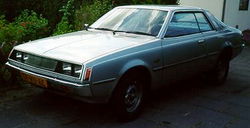 |
|
| Production | 1978–1983 |
|---|---|
| Assembly | Okazaki, Aichi, Japan |
| Body style(s) | 2-door coupe |
| Engine(s) | 1.6 L (~98 cu in) 4G32 I4 2.6 L (~159 cu in) 4G54 I4 |
| Transmission(s) | 5-speed manual 3-speed automatic |
| Wheelbase | 2530 mm (99.6 in) |
| Length | 4525 mm (178.1 in) |
| Width | 1675 mm (65.9 in) |
| Height | 1345 mm (53 in)–1355 mm (53.3 in) |
| Related | Mitsubishi Galant Lambda Plymouth Sapporo |
- See Mitsubishi Galant Lambda for more information
The Challenger name was revived in 1978 for a version of the early Mitsubishi Galant Lambda coupe, known overseas as the Mitsubishi Sapporo/Scorpion and sold through Dodge dealers as a captive import, identical except in color and minor trim to the Plymouth Sapporo. Although mechanically identical, the Dodge version emphasized sportiness, with bright colors and tape stripes, while the Plymouth emphasized luxury, with more subdued trim. Both cars were sold until 1983, until being replaced by the Conquest and Daytona.
The car retained the frameless hardtop styling of the old Challenger, but had only smaller engines (inline-4 instead of the six and eight-cylinder engines from the old Challenger) and was a long way in performance from its namesake. Nevertheless, it acquired a reputation as a reasonably brisk performer of its type, not least because of its available 2.6 L engine, exceptionally large for a four-cylinder. Four-cylinder engines of this size had not usually been built due to inherent vibration, but Mitsubishi pioneered the use of balance shafts to help dampen this effect, and the Challenger was one of the first vehicles to bring this technology to the American market; it has since been licensed to many other manufacturers.
Third generation (2008–present)
 |
|
| Production | 2008–present |
|---|---|
| Assembly | Brampton Assembly plant in Canada[8] |
| Class | Pony car |
| Body style(s) | 2-door coupe |
| Platform | Chrysler LC platform |
| Engine(s) | 3.5 L (214 cu in) SOHC V6 (2009-present) 5.7 L (345 cu in) HEMI V8 (2009-present) 6.1 L (370 cu in) HEMI V8 (2009-2010) 6.4 L (392 cu in) HEMI V8 (2011-) |
| Transmission(s) | 4-speed Automatic 5-speed Automatic 6-speed Manual |
| Wheelbase | 116.0 in (2946 mm) |
| Length | 197.7 in (5022 mm) |
| Width | 75.7 in (1923 mm) |
| Height | 57.0 in (1448 mm) |
| Related | Chrysler 300 Dodge Charger Dodge Magnum Mercedes-Benz E-Class Mercedes-Benz S-Class |
On December 3, 2007, Chrysler started taking deposits for the third-generation Dodge Challenger which debuted on February 6, 2008 simultaneously at the Chicago Auto Show[9] and Philadelphia International Auto Show. Listing at US$40,095, the new version is a 2-door coupe which shares common design elements with the first generation Challenger, despite being significantly longer and taller. The chassis is a modified (shortened wheelbase) version of the LX platform that underpins the 2006-Current Dodge Charger, 2005-2008 Dodge Magnum, and the 2005-Current Chrysler 300. The LX platform was adapted from the Mercedes E Class, reflecting the German company's ownership of Chrysler at the time and quest for economies of scale. All (7119) 2008 models were SRT8s and equipped with the 6.1 L (370 cu in) Hemi and a 5-speed AutoStick automatic transmission. The entire 2008 US run of 6,400 cars were pre-sold (many of which for above MSRP), and production commenced on May 8, 2008; Chrysler Canada offered a further 670+ SRTs uniquely badged as the Challenger 500(paying homage to Charger and Coronet 500s) all of which were shipped to Canadian Dodge dealers. Chrysler of Mexico is offering only 100 of this car for that country with a 6.1 liter V8 and 425 brake horsepower (317 kW) (SAE); the version is SRT8. Chrysler auctioned off two 2008 SRT8 for charity with car #1 going for $400,000.00 to benefit the notMYkid non-profit organization, and a "B5" Blue #43 car fetching a winning bid of $228,143.43 with the proceeds going to Victory Junction Gang Camp.[10]
2009
Production of the limited edition 2008 SRT/8s ended in July 2008, and production of the expanded 2009 line-up started in early August of the same year. The expanded offering was the same as had been unveiled earlier that spring at the 2008 New York Auto Show. Chrysler debuted the full Dodge Challenger line for 2009, with four different trims - SE, R/T, SRT8, and the SXT in Canada only. In addition to the SRT8, which remained unchanged except for the optional 6 speed manual, the line-up included the previously mentioned SE and SXT which offered the 250 HP 3.5 V6, and the R/T which hosted a 5.7 Hemi sporting 370 hp (276 kW) and 398 lb·ft (540 N·m) of torque when coupled with the 5 speed automatic, and 375 hp (280 kW) and 404 lb·ft (548 N·m) when matched with the same Tremec 6 speed manual stick as the SRT8.
2010
For 2010 models, the vehicle will cost $515 to $1,010 higher than 2009 cars.[11] The color, HEMI Orange, was initially dropped for the 2010 model year, then re-released later for the 2010 model year. Two new color schemes will be available for November 2009 for the 2010 model year including the Plum Crazy and Detonator Yellow.[12] A third new color, Furious Fuschia was announced in February 2010.[13] But unlike previous special editions, the Furious Fuschia version will have significant changes to the interior with white leather instead of the usual black seats. Chrysler also made a late-year addition to the 2010 model year with the limited edition Mopar '10 Challenger R/T. These cars, limited to only 500 examples, were metallic gray in color with three accent colors of stripes to choose from. In addition, these cars were available with black R/T Classic-style rims along with a Hurst aftermarket pistol grip shifter, custom badging, Mopar cold air intake for a 10 horsepower increase, and Katzkin-sourced aftermarket interior.
Total American sales
| Calendar Year | Sales |
|---|---|
| 2008[14] | 17,423 |
| 2009[15] | 25,852 |
SE

The base model Challenger is powered by a 3.5 L (214 cu in) [16] SOHC V6 producing 250 brake horsepower (190 kW) (SAE) and 250 lb·ft (339 N·m) torque which was coupled to a 4-speed automatic transmission for the first half of 2009, then was changed to have a 5 speed automatic transmission standard equipment for the second half of the 2009 model year and on.[17] Several different exterior colors, and either cloth or leather interiors are available. Standard features include air conditioning; power windows, locks, and mirrors; cruise control; and 17-inch (430 mm) aluminum wheels. Leather upholstery, heated front seats, sunroof, 18-inch aluminum wheels, and a premium audio system are available as options, as are ABS, and stability and traction control.[18] The Canadian market also sports the SXT trim, similar to the SE, however is even more generous in terms of standard features. Some of these features being ESP, an alarm system, and 18-inch (460 mm) wheels.
SE Rallye Package
New for 2009 is the Rallye Package for the SE model. The Challenger SE Rallye Package features design cues including dual body stripes on the hood and the trunk, chromed ‘FUEL’ door, deck lid spoiler, 18-inch aluminum wheels, and Micro Carbon in the interior accents.
Exterior paint colors and dual-stripe combinations on the Dodge Challenger SE Rallye include:
- Brilliant Black Crystal Pearl - with Dark Gray dual stripes and Red accent stripes
- Bright Silver Metallic - with Dark Gray dual stripes and Red accent stripes
- Deep Water Blue Metallic - with White dual stripes and Red accent stripes
- Inferno Red Crystal Pearl - with Black and Dark Gray accent stripes
- TorRed - with Black dual stripes and Dark Gray accent stripes
- Dark Titanium Metallic - with Black dual stripes and Red accent stripes
- Stone White - with Black dual stripes and Red accent stripes
R/T

The mid-level Challenger is powered by a 5.7 L (345 cu in) Hemi V8 coupled to a 5-speed automatic transmission or a Tremec TR-6060 6-speed manual transmission. On cars equipped with the automatic transmission, the engine features the Multi-Displacement System and produces 372 brake horsepower (277 kW) (SAE) and 398 lb·ft (540 N·m) torque.[17] With the 6-speed manual transmission, the Multi-Displacement System option is deleted and the engine produces 376 brake horsepower (280 kW) (SAE) and 404 lb·ft (548 N·m) torque.[17] Another feature is the Intelligent Deceleration Fuel Shut-Off (iDFSO) available with the manual and the automatic models, the first to combine both Multi-Displacement system and fuel shut-off.[19] The final drive ratio is 3.06:1 on cars with the automatic transmission, 3.73:1 on cars with the 6-speed manual and 18-inch (460 mm) wheels or 3.92:1 with the 6-speed manual and optional 20-inch (510 mm) wheels. Also available on R/T is the "Track Pak" option group, which includes the Tremec manual transmission, a limited slip differential and self-leveling rear shock absorbers. During the end of the 2010 model year, Dodge released the special edition "Mopar '10" Challenger R/T. The Mopar '10 featured a myriad of Mopar aftermarket upgrades straight from the factory including a Mopar cold air intake, hurst pistol grip shifter, custom Katzkin leather interiors and R/T Classic wheels that are painted black as opposed to the standard chrome. All Mopar '10s had metallic gray paint to go along with a choice of three different colors for exterior striping.
R/T Classic

The Challenger R/T Classic, with the 5.7 L (345 cu in) Hemi, and retro aspects such as script "Challenger" badges on the front panels and black "R/T" stripes. It comes with a five speed automatic, standard, with an optional six-speed manual transmission including a pistol-grip-shifter. Available in Brilliant Black Crystal Pearl, Bright Silver Metallic, Stone White and in five "heritage" colors: HEMI-Orange, TorRed, B5 Blue, Plum Crazy Purple and Detonator Yellow. Prices start at $34,005 (including destination) and production started in February 2009.
SRT8
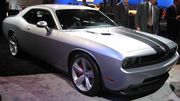
The 2009 SRT8, while still equipped with the 6.1L Hemi V8, is virtually identical to its 2008 counterpart, with the main difference being the choice of either a 5-speed automatic or a 6-speed manual transmission. Standard features include Brembo brakes, a sport suspension, bi-xenon headlamps, heated leather sport seats, keyless go, Sirius satellite radio, and 20-inch (510 mm) forged aluminum wheels in addition to most amenities offered on the lower R/T and SE models such as air conditioning and cruise control.[18] In addition, the 2009 will have a true "limited slip" differential.[20] A "Spring Special" SRT8 Challenger was also offered in B5 Blue, but due to rolling plant shutdowns, just over 250 Spring Special Challengers were built before the end of the 2009 model year. For 2010, SRT8 models add Detonator Yellow as an available color (at extra cost), and only with the optional "Special Edition Group". Yellow Challengers will only be built for a limited time (October/November 2009). Another retro color, Plum Crazy Purple, was also available during Spring 2010 production, offered exclusively in the "Spring Special" package. Another retro color, Furious Fuschia, similar to the 70s Panther Pink, was limited to one-day production at the Brampton, Ontario plant.[13]
SXT
The SXT version of the Challenger is only sold in Canada and is a more well-equipped variation of the SE. It adds fog lamps, a rear spoiler, larger wheels, illuminated vanity mirrors, security alarm and a leather-wrapped shifter. In addition, the SXT has increased option packages available to it that aren't available on the SE. (Such as the high-end navigation-enabled entertainment system.)
Super Stock Concept
The Super Stock Concept was built to commemorate the 50th anniversary of 392 Hemi engine, as well as showcase Mopar's new available 392 (6.4L) Hemi crate engine. The body was based on the 2006 Dodge Challenger Concept. The vehicle was unveiled at SEMA show.[21]
SRT10 Concept
A concept vehicle using Dodge Viper SRT-10 engine and Bilstein shocks appeared in 2008 SEMA show.[22]
Drag Race Package
A race model designed for NHRA competition, based on Dodge Challenger SRT-8. The car is 1,000 pounds (454 kg) lighter than the street vehicle by eliminating major production components and systems. To accentuate the weight savings, they also feature added composite, polycarbonate and lightweight components designed for drag racing that will be part of the new Package Car program. The engine was repositioned to improve driveline angle and weight distribution. The 116-inch (2,900 mm) wheelbase was shortened by ½ inch. They also feature a front cradle with bolt-in crossmember and solid engine mounts.
At least 50 Challenger Drag Race Package Cars are being built to meet NHRA requirements. Engine options include 6.1L HEMI, 5.7-L HEMI, 5.9L Magnum Wedge. Manual or automatic transmissions are available, The initial run of the required 50 cars has been completed and over 100 of the "2009 Challenger Drag Pak" vehicles will be produced. Currently a 2010 program is being considered. "Big Daddy" Don Garlits bought the first drag race package car and plans to race it in NHRA competition.[23] The prototype cars shown at SEMA were built by MPR Racing of Michigan, they continue to modify the production cars as delivered from Mopar, currently the "Drag-Pak" cars running in legal A/SA trim are running around the 9.7-10 second mark at 130-140 mph in the quarter mile.
Shortly after Dodge announced the Drag Pak program Ford decided to throw its hat into the competitive "Package Car" arena of NHRA drag racing. The Super Cobra Jets were built as Fords direct answer to the Challenger Drag Pak program. These cars are currently being sought as collector items because of their unique features and future value.
1320 Concept
First shown at the 2009 SEMA show in Las Vegas, the 1320 is a concept car based on the Drag Race Package. It was fabricated by Mopar's design team as a lightweight version that uses carbon-fiber components and a reduced interior. Other modifications include Mopar police wheels, an electric exhaust bypass, ARB locking differential and Mickey Thompson street-legal drag radials. It is named after the length of a quarter mile which is 1320 ft [24]
Racing
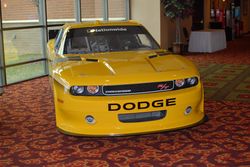
- The Challenger was introduced to the SCCA Trans Am Series in 1970. Two factory-backed cars were prepared by Ray Caldwell's Autodynamics and driven by Sam Posey and Tony Adamowicz. The #77 car was built at Autodynamics from a street Challenger T/A that was taken from a local dealer showroom. The #76 chassis arrived mid-season from Dan Gurney's All-American Racers, and was completed by Autodynamics. Also see "Challenger T/A" above.
- Dodge's mid-1970s factory-supported "Kit Car" program for short-track late-model stock car racing offered a choice of Challenger or Aspen bodies over a steel-tube chassis.
- Blackforest Motorsports has currently entered a Challenger in the Continental Challenge.[25]
- The 2010 Challenger R/T has been named as the Chrysler model for the 2010 NASCAR Nationwide Series competition.
See also
- Dodge Charger
- Plymouth Barracuda—Chrysler's other pony car
- Ford Mustang, Mercury Cougar, Chevrolet Camaro, Pontiac Firebird, AMC Javelin—the competition
- List of Dodge automobiles
- List of Dodge concept vehicles
- Vanishing Point, film notably featuring the Challenger
References
- Inline
- ↑ Gunnell, John (2005). American Cars of the 1960s. Krause Publications. p. 69. ISBN 9780896891319. http://books.google.com/books?id=_apeyhD-Dj8C&pg=PA69&dq=As+Dodge’s+answer+to+the+Mustang+and+Camaro&ei=zxC2SMsqgZLIBLKi5NcM&sig=ACfU3U0gbe0xvwpl3CDd2vcNmoRtpR5KRg.
- ↑ 2.0 2.1 2.2 “Dodge Challenger and Plymouth Barracuda”, Edmunds Inside Line, March 13, 2006. Retrieved on September 26, 2008.
- ↑ Statham, Steve (2000). Dodge Dart and Plymouth Duster. Motorbooks. p. 21. ISBN 9780760307601. http://books.google.com/books?id=Jz-ItcylfasC&pg=PA21&dq=a+rather+late+response+to+the+ponycar+wave+the+Ford+Mustang+had+started&ei=bhG2SMymHIyYyASik4jSBQ&sig=ACfU3U215uE_1nyOre66bj6Lt6hLSJXdQw.
- ↑ Genat, Robert (1999). Hemi Muscle Cars. MotorBooks/MBI. pp. 61, 63. ISBN 9780760306352. http://books.google.com/books?id=L8TcfqcZ_cwC&pg=PA63&dq=Dodge+was+to+be+positioned+against+the+Cougar&ei=Dhi2SMjyCI3kywTb0NnpCg&sig=ACfU3U2SJ1TfJ9th10otgIb-HPJLPX5E3Q.
- ↑ Newhardt, David (2000). Dodge Challenger & Plymouth Barracuda. MotorBooks/MBI. p. 42. ISBN 9780760307724. http://books.google.com/books?id=3bQmUlA2QWEC&pg=PA42&dq=Dodge+was+to+be+positioned+against+the+Cougar&ei=Dhi2SMjyCI3kywTb0NnpCg&sig=ACfU3U1Mqjhb9LnJH0ton62_1EaGOgxZxg.
- ↑ "1970–1974 Dodge Challenger", by the auto editors of Consumer Guide. October 17, 2007, retrieved on August 27, 2008.
- ↑ "Dodge Challenger – The Car That The World Prefers". http://www.car-lots.net/dodge-challenger.htm.
- ↑ "Chrysler Celebrates Production of All-New 2008 Dodge Challenger SRT8(R)". The Auto Channel. http://www.theautochannel.com/news/2008/05/08/086423.html.
- ↑ "Dodge Swamped With Challenger Orders". Inside Line. http://www.edmunds.com/insideline/do/News/articleId=123858.
- ↑ "SOLD! #43 Dodge Challenger SRT/8 Raises $228,143.43 for Charity". http://www.redletterdodge.com/2008/02/23/sold-43-dodge-challenger-srt8-raises-22814343-for-charity/.
- ↑ "Chrysler Announces Price Hikes on 2010 Dodge Challenger". Edmunds.com. 2009-08-18. http://www.edmunds.com/insideline/do/News/articleId=155326. Retrieved 2010-08-06.
- ↑ "2010 - Challenger - Muscle Car, Performance Car, Sedan". Dodge. http://www.dodge.com/en/2010/challenger/. Retrieved 2009-11-23.
- ↑ 13.0 13.1 "Chrysler Blog - Fast and Furious Fuschia". Blog. chryslerllc.com. http://blog.chryslerllc.com/blog.do?id=921&p=entry. Retrieved 2010-08-06.
- ↑ "December 2008 Sales: Chrysler LLC". CheersandGears.com. 2009-01-05. http://www.cheersandgears.com/topic/27526-december-2008-sales-chrysler-llc/. Retrieved 2009-01-05.
- ↑ "Chrysler Group LLC December 2009 Sales". CheersandGears.com. 2010-01-05. http://www.cheersandgears.com/topic/50556-chrysler-group-llc-december-2009/. Retrieved 2010-01-05.
- ↑ "Bridge - Vehicle Suite". Dodge. http://www.dodge.com/bridge/vehsuite.html?app=vehiclespecs&family=charger&model=Technical&zipcode=10101&year=2008. Retrieved 2009-05-01.
- ↑ 17.0 17.1 17.2 "2009 Dodge Challenger Specs". JB car pages. http://www.jbcarpages.com/dodge/challenger/2009/specs/.
- ↑ 18.0 18.1 "2009 Dodge Challenger Review". JB car pages. http://www.jbcarpages.com/dodge/challenger/2009/.
- ↑ "Chrysler adds fuel shutoff to increase mileage | Allpar Chrysler, Dodge, and Jeep News". Allpar.com. 2009-07-07. http://www.allpar.com/news/index.php/2009/07/chrysler-adds-fuel-shutoff-to-increase-mileage. Retrieved 2009-11-23.
- ↑ "SRT Engineers Chat Session". Challenger Forum. http://www.challengertalk.com/forums/f30/summary-srt-chat-session-2017/.
- ↑ Neff, John (2006-10-30). "Chrysler's SEMA surprise: 392 HEMI Dodge Challenger Super Stock". Autoblog.com. http://www.autoblog.com/2006/10/30/chrysler-s-sema-surprise-392-hemi-dodge-challenger-super-stock/. Retrieved 2010-08-06.
- ↑ Neff, John (2008-10-14). "SEMA Preview: Dodge bringing Viper-powered Challenger SRT10 Concept". Autoblog.com. http://www.autoblog.com/2008/10/14/sema-preview-dodge-bringing-viper-powered-challenger-srt10-conc/. Retrieved 2010-08-06.
- ↑ "Mopar Dodge Challenger Drag Pack Finally Revealed". Jalopnik.com. http://jalopnik.com/398484/mopar-dodge-challenger-drag-pack-finally-revealed. Retrieved 2010-08-06.
- ↑ "2009 Dodge Challenger 1320". Supercars.net. http://www.supercars.net/cars/4627.html. Retrieved 2009-10-30.
- ↑ "Event Information - Entry List". Grand-am.com. 2010-01-10. http://www.grand-am.com/schedule/entrylist.cfm?series=k&eid=1502. Retrieved 2010-08-06.
- General
- MyMopar: Challenger production numbers
- Dodge Challenger: History of the Dodge Pony Car from Chrysler Media Site
External links
- 2009 Challenger Official Site
- 2009 Challenger R/T Road Test
- 2009 Dodge Challenger Video Reviews
- 2010 Challenger Official Site
| Type | 1980s | 1990s | 2000s | 2010s | ||||||||||||||||||||||||||||
| 0 | 1 | 2 | 3 | 4 | 5 | 6 | 7 | 8 | 9 | 0 | 1 | 2 | 3 | 4 | 5 | 6 | 7 | 8 | 9 | 0 | 1 | 2 | 3 | 4 | 5 | 6 | 7 | 8 | 9 | 0 | 1 | |
| Subcompact | Omni | |||||||||||||||||||||||||||||||
| Colt | Colt | Colt | Colt | |||||||||||||||||||||||||||||
| Omni 024 | Charger | |||||||||||||||||||||||||||||||
| Compact | Colt | 400 | Shadow | Neon | Neon | Caliber | ||||||||||||||||||||||||||
| Aspen | Aries | |||||||||||||||||||||||||||||||
| Mid-size | Lancer | |||||||||||||||||||||||||||||||
| Mirada | 600 | Spirit | Avenger | |||||||||||||||||||||||||||||
| Diplomat | Dynasty | Stratus | Stratus | |||||||||||||||||||||||||||||
| Full-size | St. Regis | Monaco | Intrepid | Intrepid | Magnum | |||||||||||||||||||||||||||
| Charger | Charger | |||||||||||||||||||||||||||||||
| Sport compact | Daytona | Avenger | SRT-4 | |||||||||||||||||||||||||||||
| Sports | Challenger | Conquest | Stealth | Challenger | ||||||||||||||||||||||||||||
| Viper | Viper | Viper | Viper | |||||||||||||||||||||||||||||
|
|||||||||||||||||||||||